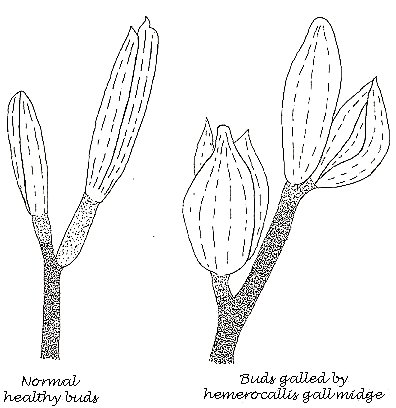Hemerocallis Gall Midge
Courtesy of the Royal Horticultural Society, England
The hemerocallis gall midge Contarinia quinquenotata is a specific pest of daylilies (Hemerocallis species and cultivars). It is of widespread occurrence in northern and central Europe but was not found in Britain until June 1989, when samples of the distinctively damaged flower buds were brought to the Advisory Service at Wisley from a private garden in Weybridge, Surrey. It had evidently been in Britain unnoticed for at least one year prior to that as it soon became apparent that the infestation was more widespread than the Weybridge area. Since then, hemerocallis gall midge has continued to spread but is still largely confined to south east England. All the samples received at Wisley up to the end of 2000 were south of a line drawn from the Severn to the Wash, with no records as yet from south west England.
The midge overwinters in the soil and adults emerge during May-June. The females, which are 2mm long greyish-brown flies, lay eggs on the developing flower buds. The larvae are semi-transparent white maggots that grow up to 3mm long. They develop within the buds and their feeding activities cause buds to become abnormally squat and swollen. Galled buds fail to open and either dry up or rot. The petals within the buds are abnormally swollen and crinkled, and larvae can be found living at the base of the petals in a watery liquid. As many as 382 larvae have been found in a single bud, which may be the progeny of more than one female. When fully fed, the larvae leave the buds and go into the soil where they overwinter inside silk cocoons. There is only one generation a year and flower buds that develop after the first week of July are likely to escape damage. Galled buds begin to appear during late May or early June. In severe attacks a large proportion of the buds developing during June may fail to open.

CONTROL MEASURES
None of the pesticides available to amateur gardeners carries any label recommendations for use against gall midges. The larval stage is concealed within the buds and therefore difficult to reach with a pesticide. The adult stage is more vulnerable but is active over a period of about six weeks during which egg laying can take place. Galled buds should be picked off and destroyed before the larvae are able to complete their feeding. This will reduce damage in the following year but the effectiveness of this depends on how thorough the galled bud-picking is done and whether nearby gardens also have infested plants.
Late-flowering cultivars
The RHS Garden at Wisley has a large collection of Hemerocallis species and cultivars. Since the arrival of the gall midge, records have been kept of species and cultivars which produce a worthwhile display of flowers after the period of damage ends in early July. Many of the plants listed below have a flowering period that begins before that time and so they are susceptible during the early part of their flowering period. In the following list, those species and cultivars that are listed in the "RHS Plant Finder 2001-2002" are indicated in bold type. Those which are not listed may be difficult to purchase from commercial sources. The ![]() symbol indicates that the cultivar has been awarded the RHS Award of Garden Merit (AGM). A * indicates that the plant was producing a good show of flowers in mid-July; **indicates that the flowering period extends into early August. Colours (y=yellow; o=orange; p=pink; r=red; pu=purple; a=apricot; c=cream) refer to the main colour of the flower.
symbol indicates that the cultivar has been awarded the RHS Award of Garden Merit (AGM). A * indicates that the plant was producing a good show of flowers in mid-July; **indicates that the flowering period extends into early August. Colours (y=yellow; o=orange; p=pink; r=red; pu=purple; a=apricot; c=cream) refer to the main colour of the flower.
Apple Tart *r
Aten **y
Azur *o
Banbury Canary *y
Barbary Corsair *pu
Bibury *o
Blushing Belle *o
Bowl of Roses *o
Burford *y
Burning Delight *o
Butterscotch Charm **y
Cartwheels *y
Chartreuse Magic *y
Chief Sarcoxie *r
Chicago Sugar Plum *pu
Christmas Is *r/y
Cinnamon Glow *o
Colour Me Mellow *y
Corky *y
Cynthia Mary **r
Daring Reflection **pu
Ed Murray **pu
Fairy Tale *a
Fiery Messenger *r
Frans Hals **y
George Cunningham *y
Gold Crest *y
Golden Gate *y
Golden Peace **o
Golden Scroll *o
Green Flutter **y
Heaven's Trophy **o
Helios *r
Hemerocallis fulva **o
H. fulva 'Flore Pleno' **o
H. lilioasphodelus **o
H. multiflora **o
His Pastures Green *y
Jake Russell *y
Jane Graham *o
Janet *y
Joan Senior **c
Lady Fermor Hesketh *y
La Peche *a
Lemon Bells *y
Little Grapette *pu
Little Wine Cup **pu
Loving Memories *c
Luminous Jewell *c
Magic Dawn *p
Marion **y
Marion Vaughn **y
Michele Coe **o
Mighty Mogul **pu
Missenden *r
Moroccan Summer **y
Neyron Rose *p
Nob Hill **y
Nova **y
Optic Elegance **y
Oriental Ruby **r
Pardon Me **pu
Peaks of Otter **pu
Pink Damask **p
Pink Prelude **p
Prairie Charmer *a/pu
Red Precious **r
Ruffled Apricot *a
Rumble Seat Romance *y/pu
Scarlet Flame **r
Stafford **r
Stella de Oro **y
Stoke Poges *p
Tetrina's Daughter **o
Torpoint *o
Veiled Organdy *y
Viva Shanti **pu/r
Washington Duke Memorial *o
Welcome Mat *o
Whichford *y
White Coral *a
Windsong *y
The above is not an exhaustive list of late-flowering cultivars and there are likely to be others that are not grown at Wisley.
Notes
Please remember that this information is specific to south east England.
The above extract from The Royal Horticultural Society Entomology Advisory Leaflet Number 28, May 2001 and the accompanying line drawing are reproduced here by permission of Andrew Halstead, Senior Entomologist with the RHS. They are RHS copyright and are not to be copied or reproduced without prior permission.